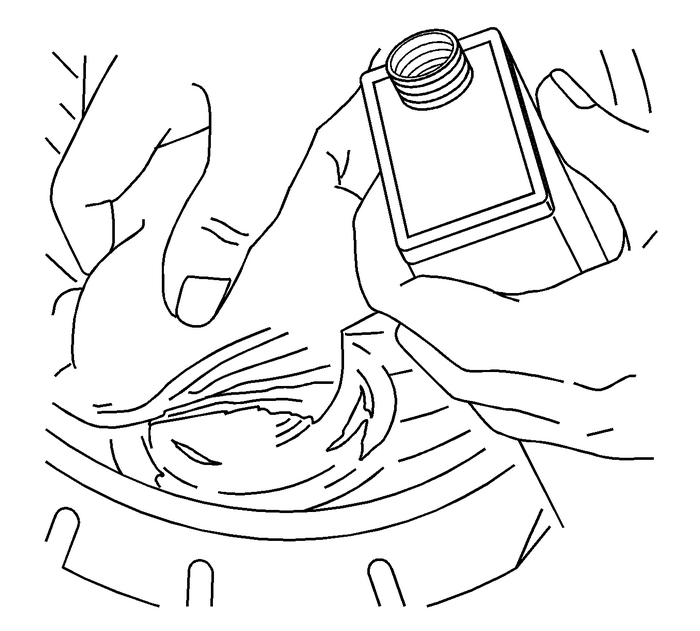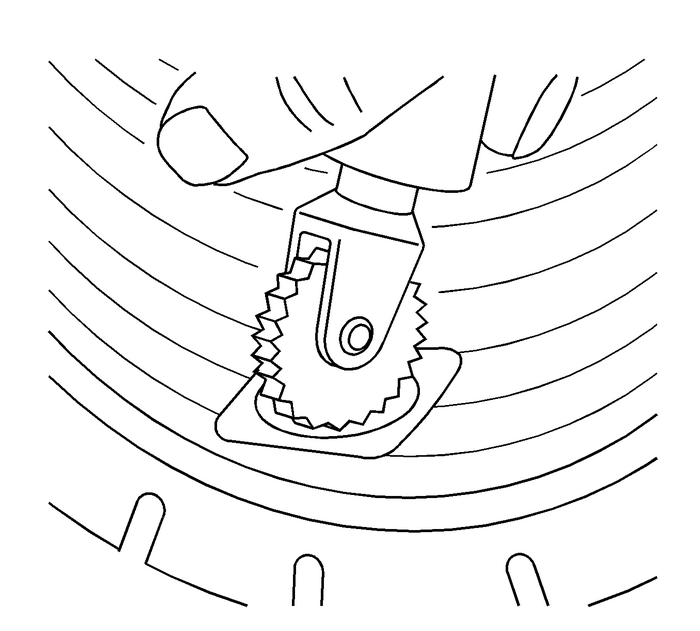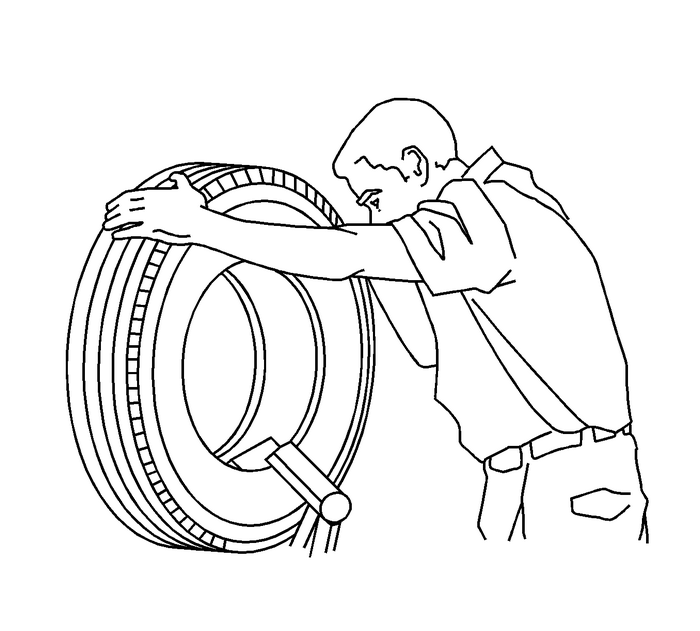Chevrolet Equinox Service Manual: Tire Repair Wheels

Warning:
Tire changing can be dangerous and should be done by trainedprofessionals using proper tools and procedures. Always read andunderstand any manufacturer's warnings contained in their customersliterature or molded into the tire sidewall.Serious eye and ear injury may result from not wearingadequate eye and ear protection while repairing tires.NEVER inflate beyond 275-kPa(40-pounds) pressure to seat beads.NEVER stand, lean or reach over the assembly duringinflation.Note:Repairable area on a radial tire.
NEVER repair tires worn to the tread indicators1.59-mm (2/32-in) remaining depth.NEVER repair tires with a tread puncture larger than6.35-mm (1/4-in).NEVER substitute an inner tube for a permissible ornon-permissible repair.NEVER perform an outside-in tire repair (plug only, on thewheel).Every tire must be removed from the wheel for properinspection and repair.Regardless of the type of repair used, the repair must sealthe inner liner and fill the injury.Consult with repair material supplier/manufacturer for repairunit application procedures and repair tools/repair materialrecommendations.Three basic steps for tire puncture repair:
Remove the tire from the wheel for inspection andrepair.Fill the injury (puncture) to keep moisture out.Seal the inner liner with a repair unit to prevent airloss.External InspectionPrior to demounting, inspect the tire surface, the valve andthe wheel for the source of the leak by using a water and soapsolution. Mark the injured area and totally deflate the tire byremoving the valve core.Demount the tire from the wheel and place the tire on awell-lighted spreader.Internal Inspection
Spread the beads and mark the puncture with a tirecrayon.Inspect the inner tire for any signs of internaldamage.Remove the puncturing object, noting the direction of thepenetration.Probe the injury with a blunt awl in order to determine theextent and direction of the injury.Remove any loose foreign material from the injury.Punctures exceeding 6.35-mm (1/4-in)should not be repaired.Cleaning

Clean the area around the puncture thoroughly with a properliner cleaner, clean cloth and a scraper. This step serves toremove dirt and mold lubricants to insure proper adhesion andnon-contamination of the buffing tool.Refer to information on the product or manufacturer'sMaterial Safety Data Sheet and follow guidelines for handling anddisposal.Clean the Injury Channel

Use a proper hand reamer, carbide cutter or drill bit to reamthe puncture channel from the inside of the tire in order to cleanthe injury.Remove steel wires protruding above the liner surface toprevent damage to the repair unit.Consult your repair material supplier for recommended reamingtool(s).Fill the Injury

It is necessary to fill the injury channel to provide back upfor the repair unit and to prevent moisture from entering the tirefabric and steel wires.For combination repair/plug units skip this step. Cement theinjured channel and fill the injury from the inside of the tirewith the repair plug per repair material manufacturer'srecommendations. Without stretching the plug, cut the plug off justabove the inside tire surface.Consult your repair material supplier for proper repairmaterial selection.Repair Unit Selection

Note:Do not install the repair unit in this step.
Center the repair unit over the injury as a reference andoutline an area larger than the unit so that buffing will notremove the crayon marks.Remove the repair unit.DO NOT overlap previous or multiple repair units.Consult your repair material supplier for proper repair unitselection.Buffing
To prevent contamination and preserve the outline, buffwithin the marked area thoroughly and evenly with a low speedbuffing tool using a fine wire brush or gritted rasp.Buff to a smooth velvet surface (RMA #1 or #2 buffedtexture).Use caution not to gouge the inner liner or expose casingfabric.Remove any buffing dust with a vacuum cleaner.Consult your repair material supplier for a proper buffingtool.Cementing

Apply chemical cement according to the repair materialmanufacturer's procedures.
Repair Unit Application
The tire must be in the relaxed position when the repair unitis installed. Do not spread the beads excessively.
Two-Piece Plug and Repair UnitsIf applicable, install the repair unit so that the alignmentis correct.Center the repair unit over the injury and stitch downthoroughly with the stitching tool, working from the centerout.
Being careful not to stretch the plug material, cut the plugflush with the outer tread.Combination Repair/Plug UnitsPull the plug through the injury until the repair justreaches the liner. Stitch down thoroughly.Follow the repair material manufacturer's recommendations forfurther installation instructions.
Consult your repair material supplier for the properstitching tool.
Safety Cage
Some run flat tires may require more than 275-kPa(40-psi) to seat the bead. In such a case, a tire safetycage must be used. Consult the tire manufacturer for its individualrepair policy.
Final Inspection
After remounting and inflating the tire, check both beads,the repair and the valve with a water and soap solution in order todetect leaks.If the tire continues to lose air, the tire must be demountedand reinspected.Balance the tire and wheel assembly. Refer toTire and Wheel Assembly Balancing - Off Vehicle.
For additional tire puncture repair information,contact:
Rubber Manufacturers Association (RMA)1400 K Street, N.W., Suite 900
Washington,DC20005-2403
Telephone: 202-682-4800
E-mail: info@rma.org
Website: www.rma.org
 Tire and Wheel Assembly Balancing - Off Vehicle
Tire and Wheel Assembly Balancing - Off Vehicle
Warning:Failure to adhere to the following precautions before tirebalancing can result in personal injury or damage tocomponents:Clean away any dirt or deposits from the inside of thewheels.Remove any ...
 Tire Inspection Wheels
Tire Inspection Wheels
We recommend that the tires, including thespare tire, if the vehicle has one, be inspected for signs of wearor damage at least once a month.Replace the tire if:The indicators at three or more places a ...
Other materials:
Lane Change Alert (LCA)
If equipped, the LCA system is a
lane-changing aid that assists
drivers with avoiding lane change
crashes that occur with moving
vehicles in the side blind zone (or
spot) areas or with vehicles rapidly
approaching these areas from
behind. The LCA warning display
will light up in the correspo ...
